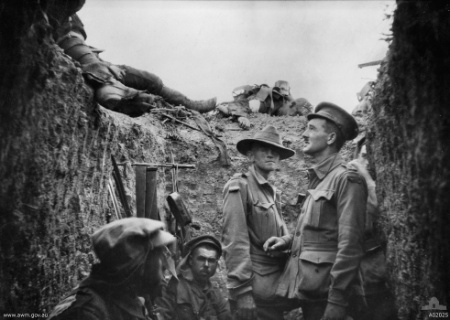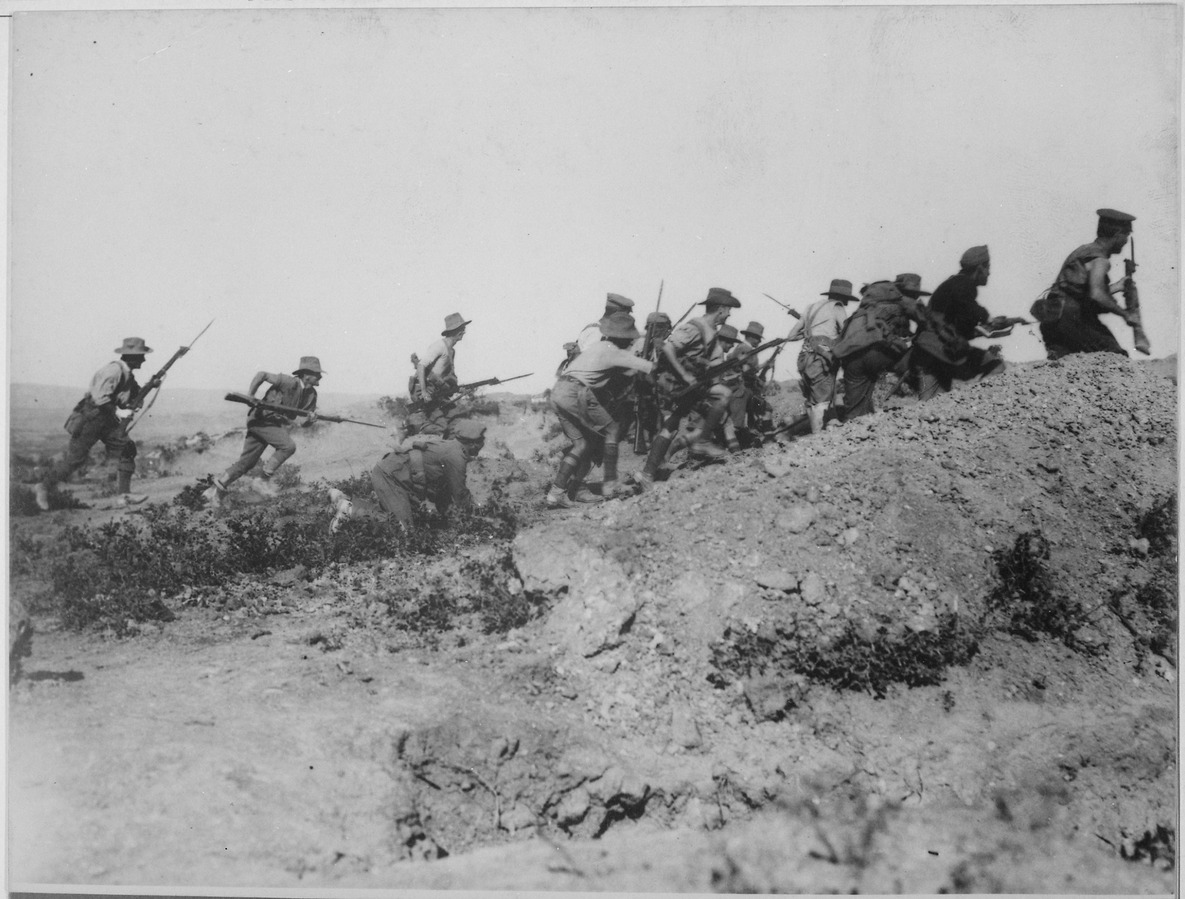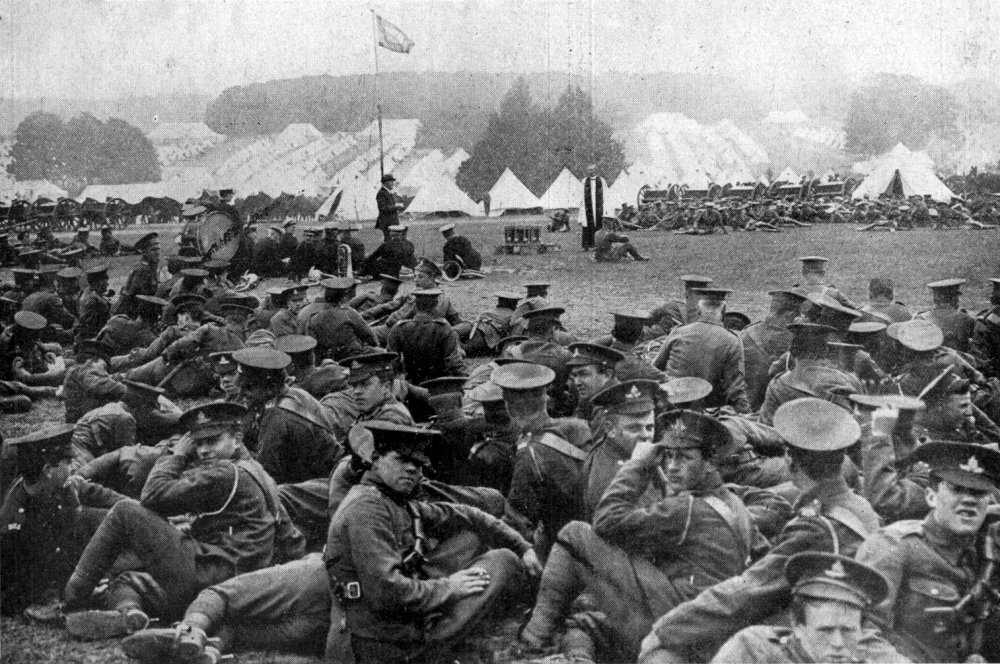Ireland has been officially neutral in terms of international conflict for around 8 decades, since the 1930s.
Yet it has not been immune from the turmoil of the 20th century, which saw the advent of the largest and most destructive wars of all history. Before its independence and establishment of neutrality, soldiers from Ireland fought in the First World War. One battle with Irish regiments was the infantry campaign of Galllipoli. This came about partly as a result of a failed naval attack on an important passage of water in modern day Turkey, the Dardanelles.
 |
| Captain Leslie Morshead looking at the dead Australian and Turkish soldiers on the parapet above the trench. |
This main naval attack was launched 100 years ago today. It aimed for the narrowest point of the Dardanelles, just 1.6km wide, with a force of 18 battleships and a supporting fleet. Yet British and French forces had failed to check for the presence of recently-laid sea mines. In tragic succession, the ships Bouvet, the Irresistable and Ocean were struck and sunk by mines, which also damaged and put out of action 3 further ships. As a consequence, for virtually no gain, the attack had resulted in the death of over 600 crewmen. What made the loss even more devastating was that the ships used for the campaign were outdated, and in fact chosen because they were perceived as ‘expendable’.[1]
Yet the tragedy of the battle had only just begun. The naval defeat was a major factor in the decision to land troops on shore to destroy Ottoman defences, thus allowing naval passage unhindered. These forces included troops from Australia, New Zealand, India and the Irish Royal Munster and Royal Dublin Fusiliers. Yet Allied forces were ill-equipped, with inaccurate maps, poor strategy, and inadequate supplies for the surroundings.
As such, losses were devastating. Irish troops approaching the shore described Ottoman firepower as “hitting off the ship and tearing people to pieces”.[2] Even amongst those who landed, in one case only 11 were unscathed out of 1012 men.[3] In total, 15,000 Irish soldiers fought during the campaign for Gallipoli, with 3000 losing their lives.[4] Batallions were often made up of friends, and so losses devastated entire communities in Ireland. Turkish forces celebrated a victory, yet at the incredible price of 87,000 dead and over 164,000 wounded.[5] Was it worth it?
 |
| Australian troops charging at a Turkish trench. It was such charges that cost so many thousands their lives to machine gun fire. Thankfully, in this case, the trench was empty. |
With all the loss of life, very little was gained. The unbearable heat of the summer months led to an epidemic of flies and lethal dysentary, while the bitterness of the winter caused some to freeze to death, and thousands to suffer frostbite.[6] The troops ashore who managed to survive ended up having to be evacuated. Furthermore, with the political turmoil of the Easter Rising of 1916 in Ireland, the courage and loss of Irish regiments in Gallipoli were sidelined. Songs were even sung mocking them for fighting for British forces.[7] After such sacrifice, many were rejected even by their own people.
Gallipoli is a tale of unnecessary waste of life. It starkly demonstrates the horrors of war that have touched every nation in our world. Yet it helps us understand the incredible price at which the peace that we enjoy has been bought. It raises a fundamental ethical issue: the value of human life. Too often, in military, political and financial spheres, people are still treated as little more than statistics and commodities.
We have a voice that can be used to question and resist this tendency. We can take a stand for the value of every single person in the world today. The only uncertainty that remains is whether we will actually do something.
For just one idea, please sign our petition standing up for the value of people affected by leprosy. It’s our way of ensuring their cause is about justice for them, not just about statistics.
Sources:
[1] T. Özakman, Diriliş (Ankara, 2008: Bilgi Yayınları), p. 686.
[2] http://www.independent.ie/life/world-war-1/sea-at-gallipoli-ran-red-with-irish-blood-30270528.html
[3] L. Rakoczy, The Archaeology of Destruction (Newcastle, 2008: Cambridge Scholars).
[4] http://www.independent.ie/life/world-war-1/sea-at-gallipoli-ran-red-with-irish-blood-30270528.html
[5] http://www.anzacsite.gov.au/2visiting/turkish_stop.html
[6] L. Carlyon, Gallipoli (Sydney, 2001: Pan Macmillan), p. 314.
[7] P. Orr, Field of Bones: An Irish Division at Gallipoli (Dublin, 2006: Lilliput Press).

